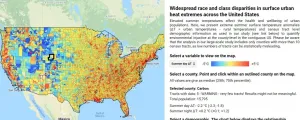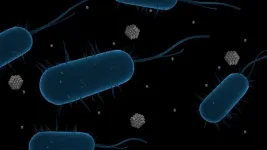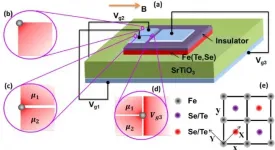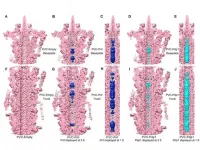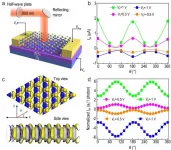(Press-News.org) WASHINGTON--In cities and towns across the United States, neighborhoods with more Black, Hispanic and Asian residents experience hotter temperatures during summer heatwaves than nearby white residents, a new study finds. It is the first to show that the trend, documented in some major cities, is widespread, even in small towns, nationwide.
According to the new nationwide study, these racial disparities exist because non-white neighborhoods tend to be more densely built up with buildings and pavement that trap heat and have fewer trees to cool the landscape.
"Urban climate is different from temperatures outside the city," said co-author Susanne Benz, an environmental scientist who conducted this research at the University of California, San Diego, and is now at Dalhousie University. "Inside the city, temperatures are affected by the buildings surrounding you and by the surface of the streets." Dark pavement absorbs sunlight and releases the heat at night, while trees and other vegetation cool an area through transpiration, when they release water vapor through pores in the leaves.
The new study is published in Earth's Future, AGU's journal for interdisciplinary research on the past, present and future of our planet and its inhabitants. The approach offers city planners and policymakers a way to identify disparities and to evaluate initiatives to address urban heat.
Summer in the city
Summer heatwaves cause more than 700 deaths each year in the United States. When heat and humidity are so high that a body can no longer cool itself through sweating, heat stroke can set in, rapidly causing brain and organ damage. People who are older, have certain chronic health conditions or are physically exerting themselves are most at risk. Urban environments are commonly hotter than their rural counterparts, and temperatures can vary even within cities. Those few degrees can mean life or death for some residents.
Benz initially had the idea for this study after reading a New York Times article finding that neighborhoods the U.S. government redlined in the 1930s--meaning they classified them as poor investments because people of color lived there--are now hotter than white neighborhoods in the same cities. She and co-author Jennifer Burney, an Earth scientist at the University of California, San Diego, realized they could do a similar analysis for the entire country.
Benz looked for urban heat patterns using land surface temperatures during summer heat waves collected by a NASA satellite. She subtracted the temperature of nearby rural locations to find variations in urban heat across towns and cities. Then she combined the temperature data with demographic information from the U.S. Census, looking at more than 1,000 counties to see who was most impacted. NOAA and USGS survey data allowed her to estimate how densely built up an area was, and the proportion of land covered by trees.
The researchers found that in 76% of counties with more than 10 census tracts, poorer neighborhoods were notably hotter than wealthier ones, primarily due to physical differences--more pavement and people and fewer trees. Areas with a larger percentage of people of color or where people had less education also experienced higher temperatures.
Big cities weren't the only places with race-related heat differences. Benz and Burney also saw the same patterns playing out in less developed areas. "It turns out that even your tiny towns have the same disparities," Benz said, "and this was something that really shocked me."
The trend held up even when they took wealth out of the picture. When residents had a similar income, non-white neighborhoods still faced significantly higher temperatures than white ones in 71% of the counties.
"The findings are really quite staggering," said Jeremy Hoffman, a climate scientist and chief scientist at the Science Museum of Virginia, who was not involved in the research. "These disparities exist across virtually every built environment in the country. Money doesn't grow on trees, but it is certainly concentrated underneath them across the U.S."
How to beat urban heat
The new analysis provides information for policymakers and establishes a way to evaluate the success of policies designed to address urban heat. "There's a lot of talk in Biden's administration about environmental justice but not so much clarity on what metrics might be used to evaluate policy proposals," said Burney. "These are very concrete metrics that can be tracked over time."
Now that officials can recognize and measure urban heat disparities, the big question is how to fix them.
Hoffman thinks it will take thoughtful investment to cool off hotter neighborhoods, such as planting trees at parks, bus stops and along pedestrian thoroughfares and providing incentives for green or white reflective roofs to cool buildings. These initiatives could dovetail with urban agriculture programs, solar panel installation, workforce development and other programs to more holistically address racial inequality.
Benz hopes that this analysis will be useful for all communities, but especially for smaller towns, whose residents can use the information to understand where disparities exist and take steps to correct them--before they become entrenched through further urbanization. She created a website where interested users can visualize where heat extremes exist in their area.
INFORMATION:
AGU supports 130,000 enthusiasts to experts worldwide in Earth and space sciences. Through broad and inclusive partnerships, we advance discovery and solution science that accelerate knowledge and create solutions that are ethical, unbiased and respectful of communities and their values. Our programs include serving as a scholarly publisher, convening virtual and in-person events and providing career support. We live our values in everything we do, such as our net zero energy renovated building in Washington, D.C. and our Ethics and Equity Center, which fosters a diverse and inclusive geoscience community to ensure responsible conduct.
Notes for Journalists:
Earth's Future is open access. Download a PDF copy of the paper here. Neither the paper nor this press release is under embargo.
Paper title:
"Widespread race and class disparities in surface urban heat extremes across the United States"
Authors:
Susanne A. Benz and Jennifer A. Burney, School of Global Policy and Strategy, UC San Diego, 9500 Gilman Drive, La Jolla CA, USA 92037
Antimicrobials are used to kill or slow the growth of bacteria, viruses and other microorganisms. They can be in the form of antibiotics, used to treat bodily infections, or as an additive or coating on commercial products used to keep germs at bay. These life-saving tools are essential to preventing and treating infections in humans, animals and plants, but they also pose a global threat to public health when microorganisms develop resistance to them, a concept known as antimicrobial resistance.
One of the main drivers of antimicrobial resistance is the misuse and overuse of antimicrobial agents, which includes silver nanoparticles, ...
The COVID-19 pandemic caused an unprecedented disruption to health care delivery, with resources shifted toward telehealth services and mass viral testing. While early studies in the pandemic highlighted differences in health care utilization among patients with commercial insurance, data from publicly insured or uninsured "safety-net" patient populations continue to emerge.
A recent study from researchers at the University of Minnesota and Hennepin Healthcare Research Institute (HHRI) is among the first to examine how different socio-demographic groups used telehealth, outpatient (i.e., clinic), emergency department and inpatient (i.e., hospital) care to test for SARS-CoV-2, the virus that causes COVID-19. ...
In particle physics, a Majorana Fermion is charge neutral and its antiparticle is just itself. In condensed matter physics, a Majorana zero mode (MZM) is a quasi-particle excitation, which appears in the surfaces or edges of topological superconductors. Unlike the ordinary particles or quasi-particles that obey boson or fermion statistics, MZM obeys non-abelian statistics, a key property that makes MZM the building block for realizing topological quantum computation. Currently major experimental efforts focus on heterostructures made of superconductors and spin-orbit coupled systems (such as semiconducting nano-wires and topological insulators), where evidences of MZMs have been found. Unambiguous detection and manipulation of MZMs in these heterostructures, ...
North Carolina State University researchers have created insecticide-free, mosquito-resistant clothing using textile materials they confirmed to be bite-proof in experiments with live mosquitoes. They developed the materials using a computational model of their own design, which describes the biting behavior of Aedes aegypti, the mosquito that carries viruses that cause human diseases like Zika, Dengue fever and yellow fever.
Ultimately, the researchers reported in the journal Insects that they were able to prevent 100 percent of bites when a volunteer wore their clothing - a base layer undergarment and a combat shirt initially designed for the military - in a cage with 200 live, disease-free mosquitoes. Vector Textiles, an NC State startup company, ...
Contractile injection systems (CISs) are widely distributed in bacteria and archaea that can form a nanomachine resembling the contractile tails of bacteriophage (T4, P2, etc.) to translocate proteins and nucleic acids . The P. asymbiotica was shown to be involved in the human infection with severe skin lesions. The PVC loci within P. asymbiotica genome produce molecular needle complexes and encode several putative effector genes. It would be a candidate P. asymbiotica weapon that participates in the attack of mammalian cells, but substantial evidences will be needed to verify this hypothesis.
In this study, researchers have characterized the PAU_RS16575 as a potent PVC effector, which is widely present in bacteria. ...
To extract the polarization information of incident light, polarization-sensitive photodetectors (PSPDs) exhibit significant practical application in both military and civil areas, like bio-imaging, remote sensing, night vision, and helmet-mounted sight for fighter plane. Optical filters combined with polarizers are usually needed for traditional photodetectors to realize polarized light detection. But it will increase the size and complexity of devices. To obtain a small-size PSPD, one-dimensional (1D) nanomaterials with geometrical anisotropy, such as nanowires, nanoribbons, and nanotubes, have been used as the sensitive materials for PSPDs, which can directly identify the polarization information of incident light without any optical filters and polarizers. However, it is not ...
Google searches related to infertility and coronavirus (COVID-19) vaccines increased by 34,900% after a pair of physicians submitted a petition questioning the safety and efficacy data of the COVID-19 Pfizer vaccine. Referencing the petition, anti-vaccine activists circulated claims that misconstrued the information regarding the possibility that the vaccine could impact fertility in women.
The inaccurately represented information spread rapidly on social media channels, potentially influencing public perception and decision-making among pregnant patients or those ...
The human brain has extreme ability in thinking and computation, but it only requires a very low energy power of about 20W, which is much lower than that of electronic computers. The neuronal connections in the brain network have a globally sparse but locally compact modular topological characteristics, which greatly reduces the total resource consumption for establishing the connections. The spikes of each neuron in the brain are sparse and irregular, and the clustered firing of the neuronal populations has a certain degree of synchronization, forming neural avalanches with scale-free characteristics, and the network can sensitively respond to external stimuli. However, it is still not clear how the ...
While attending a conference at the Universidad Nacional Autónoma de México in Mexico City several years ago, Sharon Borja was struck by the story of a young man who, as a child, joined his parents repatriating to their native country of Mexico. Like millions of Mexican immigrants, the family had called the United States home for years, and having been born in the U.S., he was an American citizen. Walking one day in his newfound urban Mexican neighborhood, a couple carrying a wooden stick approached him on the street and encouraged him to ...
A new study from researchers at the University of Liverpool shows that decreasing local government funding over recent years probably contributed to declines in life expectancy in some areas of England, which was stalling even prior to the COVID-19 pandemic.
Local government funding and life expectancy in England, a longitudinal ecological study published in The Lancet Public Health, linked annual local government funding data from the Ministry of Housing, Communities, and Local Government with life expectancy and mortality data from Public Health England between 2013 and 2017.
Corresponding author Dr Alexandros ...
